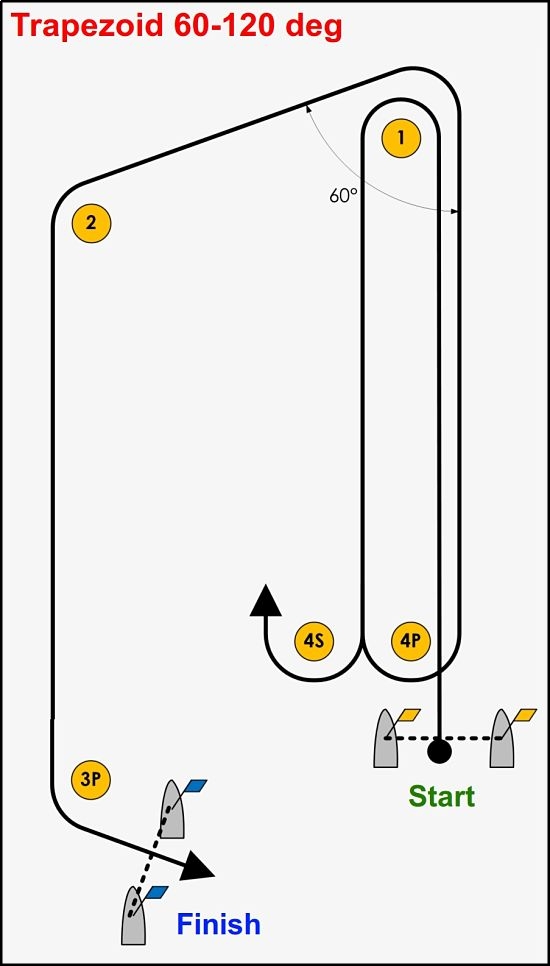How to Set Up Marks for Trapezoid Yacht Race Courses

The Trapezoid coarse provides a good way to separate mixed yacht fleets with a wide range of course options available. There are many combinations of upwind beats, Windward & Return ('sausage') legs, and the Reach between the inner and outer beats. The marks can be positioned using bearings from Mark 4 as the reference point. Often Marks 1, 2 and 3 are set up in a chain sequence by a mark laying boat. Mark 1 is positioned directly upwind of Mark 4. Mark 2 is positioned using bearings from 2 to 1 and from 2 to 4. Mark 3 is positioned directly downwind of Mark 2 and using bearings back to Mark 4. A 'protective' or 'separation' mark is often set to Port of Mark 1 to avoid congestion and interference between yachts that have rounded Mark 1 and those that are beating upwind towards it. There are various positions for the start and finish lines.
The Web Apps listed below provide bearings and back bearings for an entered wind direction. There is a Universal Tool for which the reach angles need to be entered. There is also a Universal Tool that shows the lat/longs for all course marks from an entered location, or from your own location as a reference point using geolocation. See Trapezoid LatLongThere are many pre-filled options for various popular combinations of reach angles and reach and inner beat lengths. The Web App leg lengths are percentages or proportions of the outer beat length (1/2, 2/3, Full). There is a Universal Web App that allows a huge array of combinations. Reach angles from 30-70 degrees can be entered. various combinations of Reach and Inner Beat lengths can be entered as a percentages of the Outer Beat Length. It is more difficult to change Trapezoid course layouts when the wind changes direction than for Triangle and Windward/Leeward 'Sausage' Courses. Marks 1, 2 and 3 need to be relocated using revised bearing provided by the Web Apps for the new wind direction.
Web Apps Available
The code below shows the pre-fills
=> Reach Angle + Reach Length % + Outer Beat Length % of Inner Beat
So, Trapezoid 45deg-67%-67% has a Reach angle of 45 degrees and the Reach & Outer beat lengths are 2/3 of
the Inner Beat length.
The Lat Long versions include a geolocation tool - Refloc. This can be used to set the reference at the
bottom mark (Mark 4) when you are next to it. It works on most phones, allow 6 seconds to hone in.
Trapezoid LatLong Show lat/longs for all Course Marks.
Trapezoid LatLongDMM DMM format for Lat Longs
Trapezoid-45deg-67%-67%
Trapezoid-45deg-67%-100%
Trapezoid-45deg-50%-100%
Trapezoid-45deg-50%-50%
Trapezoid-60deg-67%-67%
Trapezoid-60deg-67%-100%
Trapezoid-60deg-100%-100%
Trapezoid-60deg-50%-100%
Trapezoid-60deg-50%-50%
Trapezoid-65deg-67%-67%
Trapezoid-65deg-67%-100%
Trapezoid-65deg-100%-100%
Trapezoid-65deg-50%-100%
Trapezoid-65deg-50%-50%
Trapezoid-70deg-67%-67%
Trapezoid-70deg-67%-100%
Trapezoid-70deg-100%-100%
Trapezoid-70deg-50%-100%
Trapezoid-70deg-50%-50%
Trapezoid Universal => Enter Reach Angle,
and Reach and Outer Beat Lengths as Percentage of the Inner Beat Length.
MAP Options - Virtual GPS Unit for Laying the Marks
Note: Works with most phones, but Smartphone with GPS is best for accurate positions. Allow 6 seconds to hone in. Enter the Lat Long for the
Reference Location Mark 3 or Mark 4 (for Trapezoid) or use the Geolocation Tool set
it for your location when you are at the mark. Once the options have been entered a map will be displayed.
Then, to set a mark, proceed in its direction using the bearings shown below the map.
Click the ShowMyLoc button to show your current position as a 'dot' on the map.
Click it again to show your new position on the map. Drop the mark when you get there.
A virtual GPS unit on your mobile. The options are:
Trapezoid DD Map DD format for Lat/Longs, MAP
Trapezoid DMM Map DMM format for Lat/Longs, MAP